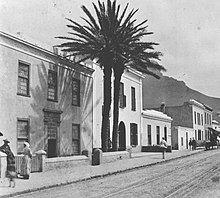Long Street (Cape Town)
The Long Street (German: "Long Road") is a street in the center of Cape Town , South Africa . Until around 1790 it was known as De Derde Berg Dwars Straat .
location
The 3.2 kilometer long road already existed 300 years ago and is one of the oldest traffic routes in Cape Town. In the early history of the city, it was the longest street here at 3.8 kilometers. Originally it reached from the harbor to Tamboerskloof, where it continues today through Kloof Street . Main street crossings form Walter Sisulu Avenue , Hans Strijdom Avenue , Strand Street , Wale Street and Orange Street starting from the direction of the port .
description
A special feature of this street are buildings in the Georgian and Victorian styles , often with wrought-iron balcony railings on their facades.
The only completely preserved structure from the 18th century is the Palm Tree Mosque (185 Long Street), a building that is too simple towards the street with a flat roof. At that time Muslims lived here, but they also met in private buildings for religious occasions. The community of this mosque was founded in 1777. The building was acquired by the Muslims Frans van Bengalen and Jan van Bougies at the beginning of the 19th century and converted into a mosque in 1807. Another mosque ( Noor el Hamedia ) is on the corner with Dorp Street . However, this dates from 1881 and has a minaret. Its structure is protected by a flat roof and the facade has window openings in the Moorish style .
When the London Missionary Society and the Netherlands Missionary Society in Cape Town were looking for a place to meet in 1799 , they first met in a building on the corner of Long Street and Hout Street . On the initiative of Rev. JP Serrurier, the construction of a church building on Long Street began in 1804 by the builder Johan Godfried Mocke and the master carpenter Joseph van Schalkhoven. FW de Wet supplied the design for the facade. The building now serves as the South African Sendinggestig Museum (40 Long Street).
The St. Martini Church of today's German Evangelical Lutheran Congregation is at the top of Long Street (240 Long Street). The church building was consecrated in 1853. The evangelical missionary work in the Cape region began as early as 1737 by a Moravian missionary from the Moravian Mission in Genadendal .
The Carnival Court building has two superimposed galleries on its elongated facade facing the street. Although relics of Georgian architecture are still recognizable, it was overprinted by subsequent changes in the Victorian style and with elements from the Art Nouveau period .
Typical building materials on and in the historic buildings are cast iron, yellowwood , stinkwood ( Ocotea bullata ) for the galleries and Robben Island slate for the flooring.
tourism
Many locals and tourists hang out on Long Street , which is a landmark. Due to the many junk and antique shops, hotels, restaurants and bars, the street is busy at all times of the day.
Web links
Individual evidence
- ↑ a b c d e Désirée Picton-Seymour, Janek Szymanowski: Historical Buildings in South Africa . Struikhof, Cape Town 1989, pp. 24-25, ISBN 0-947458-01-8
- ^ South Africa online travel guide at www.suedafrika.net, accessed on November 20, 2014
- ^ Alan Mountain: To Unsung Heritage: Perspectives on Slavery . Philip, Cape Town 2004, ISBN 0-86486-622-4 , p. 94
- ^ German Evangelical Lutheran Congregation in the center of Cape Town: The history of the St. Martini Church and Congregation . on www.st-martini.co.za (German)
- ↑ Cape Town online travel guide at www.suedafrika.net, accessed on November 20, 2014
Coordinates: 33 ° 55 ′ 19.3 ″ S , 18 ° 25 ′ 10.6 ″ E



